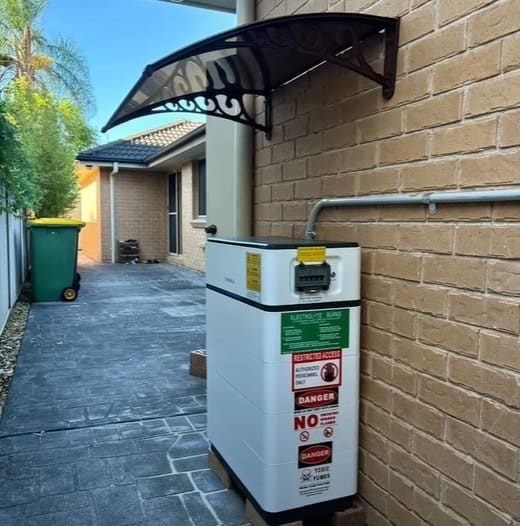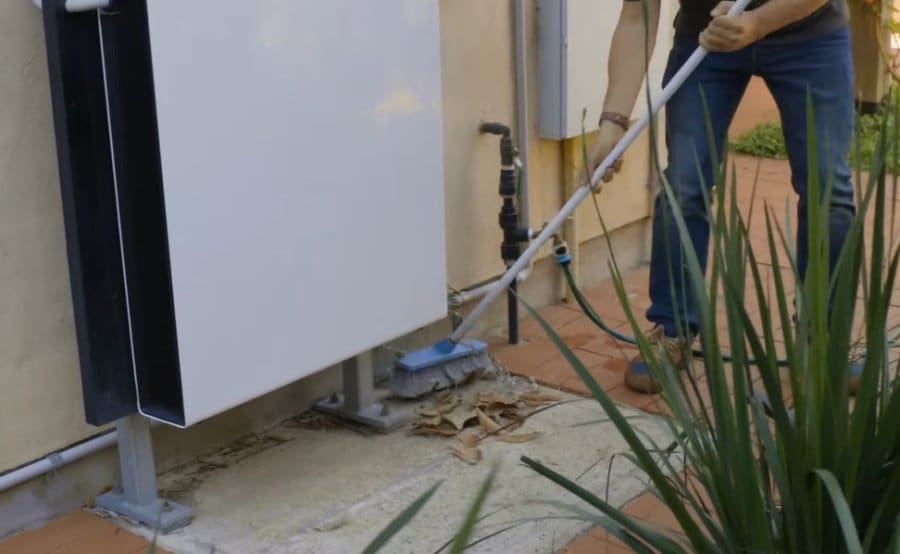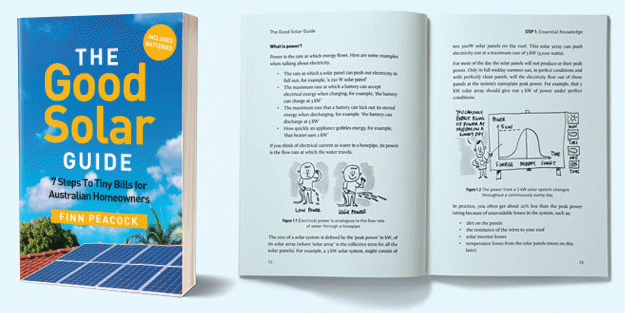Got a solar battery? Here’s how to ensure it keeps doing its job (and safely) every single day to maximse your electricity bill savings.
Hundreds of thousands of home batteries have been installed across Australia, and the number is set to really soar thanks to the upcoming federal battery rebate. The video above and this article aren’t just about owning a solar battery, but living with one.
Have You Got All The Paperwork?
Among your paperwork, you should have a ‘Single Line Diagram’ showing how everything’s wired up.
If you don’t, you’re not alone as even the best installers hate paperwork and might forget to provide this important document.
The details of the installation will have a profound effect on how your solar battery performs, which appliances are backed up, and how much money it saves you. And the Australian standard for battery installs (AS5139) says the installer needs to give you this diagram, so pursue the issue if you don’t have one.
If/when you do have a single line diagram, put it in a waterproof sleeve and stick in inside the door of your switchboard. Future electricians will thank you for this.
Beware Of Battery Killers
While a home battery is very safe under normal circumstances, if it’s installed in your garage in a vulnerable position there’s a risk of a car driving into it — so make sure sturdy bollards are protecting it.
And although solar panels spend their service lives working away in the sun, heat will shorten your battery’s life; so keep direct sunlight off it with a professional shade or cover.
Another big battery killer is water ingress. Good batteries are properly sealed, but check any isolator switches to ensure they have cables entering from the bottom, not the top. Water follows gravity, and water getting in is a recipe for disaster. This also applies to home batteries installed in a garage as condensation can get in through a top entry.
Checking Backup Features
Did you organise with your installer what the battery will back up in the event of a blackout? Do you remember what those appliances were and have you tested it out? Has your installer promised to come back and check everything’s running as it should?
Most systems won’t back up your whole house, and that’s a good thing as you don’t want to drain your battery with power hungry non-essentials. At a minimum, you want lights, fridge, internet and microwave to keep functioning in a blackout. And if you live in a hot climate and your battery has enough power and capacity, get at least one air conditioner backed up too.
There’s also a risk you might not even notice when there’s a blackout if you’ve got high quality battery backup, due to super-fast switchover times. In an extended blackout, you might go about using power as you usually would until it is depleted, and then you’ll be in the same boat as your neighbours.
It’s really important to get familiar with your battery’s app; as it should ping you when you’re running on backup power so you can be careful with what you’re using. You can also check if your home battery has a ‘minimum reserve’ setting for such emergencies. Even 20% could keep your essentials running for hours in a blackout if you’re using energy-efficient lighting and appliances.
Run A Blackout Drill
It’s pretty straightforward checking to see if your home battery backup setup is working properly.
- Pick a sunny day when your battery’s full.
- Go to your switchboard and flick off the main isolator switch. You’re now off-grid.
- Go check everything your installer promised would work.
- If you were sold ‘apocalypse proof’ backup, your solar panels should still be charging your battery. Check your app to make sure it is. But note the battery won’t charge when full, so test solar charging when around 10% of the battery’s capacity has been drained.
Your app will show how much power you are using, and the good apps will indicate how long you can last before you run out of juice. If that time-frame is short, think about items you can get by without during an emergency, and bear in mind that generally speaking, any heating or cooling will use the most energy.
Understanding Battery Modes
If you’ve bought a good solar battery, it will have at least 3 control modes:
- Self-consumption mode
- Time-based control mode
- Backup only
Self-consumption mode
Self consumption mode is best if you’re on an electricity plan with flat tariffs – it simply tries to minimise how much electricity you pull from the grid in total.
Time-based control mode
Time based control mode is for use with Time of Use (ToU) tariffs. If on a ToU electricity plan, if you ever have to pull energy from the grid, it’s better to do it when electricity is cheap. In this mode, the battery may also decide to charge from the grid instead of your solar panels sometimes; for example, charging from cheap daytime electricity when solar conditions are poor in order to get you through the expensive evening peak. With some ToU tariffs costing 8c during the day and 75c in the evening, that’s a smart move.
Backup only
Backup mode simply keeps the battery fully charged all the time – ready for a blackout to strike. It doesn’t care about lowering your bill.
Virtual Power Plant Participation
As well as these three modes, there’s another ‘mode’ not controlled by your battery, but by a third party if you’re signed up to a Virtual Power Plant (VPP) program.
When wholesale electricity prices spike, a VPP will discharge your battery. This can make big money for the VPP operator considering the wholesale price you are shielded from by your retailer can hit $15 per kilowatt-hour (kWh). A good VPP will share these profits equitably with you. You need to choose a VPP wisely as the benefits vary from program to program.
Also bear in mind the trade-off you are making — giving up control of your home battery for a few hundred bucks per year extra, so read the fine print carefully.
You also need to think about your warranted battery throughput if you sign up for a VPP. Just like most car warranties have a set kilometre limit, many solar batteries have a warranted limit on how much energy they can push in and out. Basically, the more the battery is used, the faster you’ll burn through the warranted energy throughput.
A VPP Alternative – Amber
If a VPP isn’t for you, there is an alternative if you’re willing to do a bit of work. It’s called Amber Electric. Amber doesn’t shield you from high wholesale electricity prices like a regular retailer does, but they let you keep all the profit when selling your surplus solar power or battery energy. You just a pay a monthly membership fee.
However, if you *use* energy at the wrong times, you can also get slugged with a huge bill. Or when the wholesale electricity price is negative, you can be charged for solar exports.
While there are some safeguards and Amber can provide the software to control your battery to maximise savings, there is a hands-on aspect and it’s really for advanced players only. You can get more of a feel for Amber by reading SolarQuotes’ Jono’s 12-month review of Amber for Batteries. It’s a little dated, but Jono is still an Amber customer today.
Run An Electricity Audit
If maximising savings are important to you, consider a 12 month electricity bill audit. With 12 months of data from your smart meter, there are a number of services that can analyse exactly what you used from the grid and when — and tell you if you could have had a lower bill with a different electricity plan or electricity retailer.
There is a DIY option: plug your smart meter data into to the clunky government Energy Made Easy website. But in SolarQuotes founder Finn Peacock’s experience, the results are often wrong.
If you want to pay someone to do it for you, Finn likes and recommends Bill Hero. It’s a bill monitoring service guaranteed to save you money. If you think the service will be useful and sign up to Bill Hero with this link, we’ll typically get a $20 referral fee. Thanks in advance :).
Another option is subscribing to an Australian service called Solar Analytics for a few bucks a month. In addition to providing you with user-friendly tools for tracking your solar performance and savings, the service will continuously monitor your electricity usage and your bills and email you whenever they find a better plan. According to Solar Analytics, their customers save on average $400 each year by using Plan Optimiser to choose the best retail electricity plan.
Home Battery Maintenance
Good news — while you’ll need your installer to give your solar battery a once-over every five years or so, there’s not much for you to do except brush the cobwebs off, keep the area where it is installed tidy and keep an eye on your app.
Something to be aware of though is if some batteries lose their internet connection for too long, the warranty can be voided. So, don’t change that Wi-Fi password without also updating it in your battery app.
Also note that some home batteries can be rendered useless (‘bricked’) if left without power for too long, so don’t switch them off for more than a few hours.
Very important: tell any electricians working on your house that you’ve got a battery. Even though there should be an ‘ES’ sticker on the door of your switchboard, it’s better safe than sorry — circuits may still be live even when the sparkie thinks they’ve killed the power. Show them that wiring diagram mentioned earlier.
Ageing Batteries And Performance Loss
As your battery ages, you might notice it doesn’t store as much as it used to. This is normal and another reason for buying as big a battery as you can.
3% loss per year or so is ok, but if you lose drastically more than this, you’ve got a problem.
Keep an eye on your app. If your home battery’s holding 90% capacity in year 3 but suddenly drops to 80% in year 4, there’s something wrong and you should contact your installer. And if you don’t know how to check your battery capacity with your app, ask your installer to show you.
Worst Case Scenario – Fire
Most of the time, the worst problems you’ll deal with are some error messages, and in those cases contact your installer.
While rare, lithium batteries can catch fire and these incidents aren’t like your normal house fire as they burn very hot, pump out toxic fumes and most fire extinguishers will be useless.
This isn’t a scenario for heroics. If your home battery does catch fire or looks like it’s about to, get everyone out of the house, get upwind of the fire and call 000 right away. Leave tackling it to the professionals.
A Note To EV Owners
Owners of electric vehicles should ensure their home EV charger isn’t drawing power from their solar battery under normal circumstances. An EV battery has far more capacity than a home battery and will quickly drain it. You’re usually better off charging directly from surplus solar power during the day or cheap mains grid electricity at night — or during the day on a ToU plan with cheap shoulder rates.
But what about in a blackout?
A well-configured system will let you charge your EV directly from your solar panels during a blackout so it doesn’t drain the home battery. Really well configured systems will let you override this and empty your home battery into the car battery for an emergency, such as a getaway during a zombie apocalypse!
The information above covers much of what you need to know about solar battery ownership, but you can read the full version of our home battery owner’s guide here — it goes into more detail on some aspects.




 RSS - Posts
RSS - Posts



Each of our battery modules is mounted in the shade and has a little rain deflector. That is pretty standard, but to go boots and all, there is a nearby networked smoke sensor and a nearby security camera. Handy when away from home and one of the fire sensors triggers.
Our home is two phase (not my choice) and battery is single phase although the PV supports two phases (Enphase system) Backup works fine as proven in the SE Qld cyclone when we were off grid for 10 days. It did two black starts as battery went to minimum overnight. That was barely noticed and EV charging continued onc the sun was up.
The real messy challenge was to get critical circuits on to the correct phase.
On backup #1learning curve we had to run phase 2 extension cords to three critical items. Fridge; solar hot water circulation pump; mesh router that supports the HEMS. Circuits were easily rearranged across the two phass so all criticals were backed up. The switchboard breakers were labelled by phase and backup
Sounds like a great setup, thanks for the comprehensive feedback John.
Regarding wifi passwords, these days I have numerous devices connected to wifi. I have had to change wifi routers a few times and have found that going to the new router’s settings and changing the SSID and password to those of the old router makes the transition much smoother.
Thanks Michael, a timely article ahead of the 1 July 2025 battery rebate rollout.
Thanks Michael, very helpful article.
Most people are not “electrically” trained so this is good ‘down to earth’ stuff.
Good to see the Single Line Diagrams getting the mention they need.
Being an electrical person I had to draw up my own and laminated them for durability! (Nothing provided by my contractor).
Regards
“Did you organise with your installer what the battery will back up in the event of a blackout? Do you remember what those appliances were and have you tested it out? Has your installer promised to come back and check everything’s running as it should?”
My Installer did not mention any of those points you have noted.
I don’t know what is backed up or if anything is backed up.
They are a company recommended and backed by Solar Quotes.
Hi Robert,
We’d be keen to hear who that installer is if you’d be so kind to message [email protected]
Unless you asked for backup capability you may not have it. I decided not to pay an extra $1,000 dollars for backup as I rarely need it. Instead I got a small UPS for my desktop and some light globes with back up batteries in them.
It would be great if you could do an article on upgrade/addition pathways with the battery rebate coming on line. I have a PW2 that was installed in 2019 and I am curious as to what my options might be given that PW3 doesn’t currently play with PW2.
One way to maximise the amount of power from your solar panels as well as to make the grid even greener for systems larger than the basic 6.6 kW system is to delay charging the battery until the middle of the day when there is often more power than can be used or exported to the grid within the 5 kW export limit. My battery does not start charging until 11.00 am in March and September and until noon from October 31 until March 1.
More details at:- https://www.johnrogers.com.au/solar/increasing_solar_output.html
Another possible reason for installing an oversized battery, if finances permit, is that it cycles less for a given overnight/overcast_day consumption. (My 46 kWh stack has only done 65 cycles in 1.5 years, despite being off-grid. That means calendar life becomes the limit – 20 years for LiFePO₄.) OK, batteries will be cheaper in future, so replacement of a cheaper(smaller) battery may not be any/much dearer in the long run?
Today, in deep overcast yielding only 1 kW at times, rather than take that for RCAC heating, I’ve lit the wood heater to instead use solar energy stored in convenient biomass lumps, recycling CO₂, but not adding any to the biosphere. That conserves the PV energy for battery charging – still only up to 96% at midday.
It is the 27 kW of panels which keep the system from draining the battery on a day of deep overcast. High yield trumps overdimensioned storage, but both are handy if off-grid. (On-grid, it’s only for blackouts, really.)
Just wanted to thank you for prompting me to request the SLD from my supplier (wasn’t provided in each of the 3 installation/upgrade phases we’ve had over the years). I’ve affixed a copy on the Tesla gateway so any sparkie doing work on the site can be more aware of the site config.
Regarding time-of-use charging, I had naively thought that my (current) electricity supplier, Red Energy, would align with the Ausgrid time-of-use periods. I was just checking the recent price increases and realised that is not the case. Red Energy charge peak rates from 2pm to 8pm every weekday of the year.
Fortunately most of our solar generation is in the afternoon (due to shade from trees for most of the year) so it is not necessarily a major issue. However I had to make sure our Tesla battery system had the correct ToU values to ensure it optimised battery usage. Until I updated the settings it thought that peak time started at 5pm (Ausgrid winter period).
Origin Energy recently updated the times for peak, shoulder and off-peak in South Australia on 1st July 2025 so PW3 users people should update their ToU times accordingly in the Tesla App. Don’t worry, Origin made sure they increased the rstes as well and reduced yet again the FiT, 2 cents! Wow! Hopefully my PW3 will charge on solar and shoulder before sending to the grid, which may cover the daily suppy charge (also increased) Slight changes but best to update.
I don’t have any solar, but I’m thinking of buying a battery to draw down from the grid when it cheap and use this power for evenings when it expensive. Can this be done, anyone have any recommendations.
Ideally the time based control could be automatic via an API call to the providers pricing, or a manual approach have an app, can live with both.
Hi Nick,
You probably want something like Sungrow integrated with Amber for a retail deal.
Many other inverters are well capable, but not enphase AFAIK.
Or if you’re savvy, home assistant will help maximise inverter/battery/hybrid management.
If you’re good with spreadsheets, some code and need a new hobby, look up LocalVolts to play with real time wholesale prices & peer to peer tradi g without the retailer.
Also note that the federal battery rebate only applies to homes with solar.This can save roughly $4000 for a typical battery like a Powerwall.
BTW – my rebate came through last week so the admin system is working.
thanks for the guidance, will look into the options you outlined.